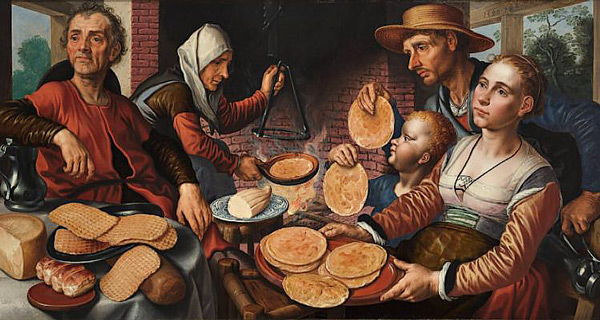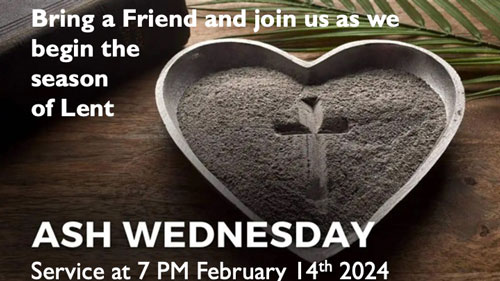1. Gospel and Sermon
2. Ash Wednesday – Invitation, Imposition of Ashes
St. Peter's Episcopal Church, Port Royal, VA

We are a small Episcopal Church on the banks of the Rappahannock in Port Royal, Virginia. We acknowledge that we gather on the traditional land of the first people of Port Royal, the Nandtaughtacund, and we respect and honor with gratitude the land itself, the legacy of the ancestors, and the life of the Rappahannock Tribe. Our mission statement is to do God’s Will in all that we do.
Almighty God, you have created us out of the dust of the earth: Grant that these ashes may be to us a sign of our mortality and penitence, that we may remember that it is only by your gracious gift that we are given everlasting life; through Jesus Christ our Savior. Amen.
We began our observation of Jesus’ death and resurrection by preparing for Easter with a season of penitence. Ash Wednesday is the first day of Lent. We had 17 in attendance. Sally Hartman who did her vocational discernment at St. Peter’s and now is a Deacon was the preacher.
The church changes its look encouraging you to see things differently – purple on the altar, minimal flowers, pottery communion cup, a special red processional cross.
The liturgy provides words about the purpose of Lent. “I invite you, therefore, in the name of the Church, to the observance of a holy Lent, by self-examination and repentance; by prayer, fasting, and self-denial; and by reading and meditating on God’s holy Word.”
It is all about reconnecting with God with by these specific activities and others of your choosing. Examine yourself to see what divides you from others, from the earth and from God, and repent from these divisive things. As the bulletin stated “only God can take away our sins, create clean hearts in us, renew a right spirit within us, and sustain us with God’s bountiful spirit.” The sermon enouraged us not to just give up but to take on new practices to do that and see other possibilities in the world.
This is Bishop Wright’s invitation to a Holy Lent and to participate in a 5-part Lenten teaching series. “Letting Go” is letting go of those things and ways that hold us back- weights, obstacles, and sin.

Pieter Aertszen’s The Pancake Bakery, circa 1508
Great weather and 20 in attendance on this day before Lent begins:
Photos, Feb. 13, 2024
Click here to view in a new window.
The Christian practice of listing vices and virtues has a long history, going back at least to the times of the very early desert monks in the fourth and fifth centuries. As they cultivated their little patches of land in order to sustain themselves, they also cultivated their bodies and souls to make them as fruitful as they could. Later, medieval Christian manuscripts featured the motif of the ‘virtue garden’, in which the virtues (usually seven) are shown as trees, being watered by prayer.
Christianity, like Judaism, likes having things in sevens. The sixth-century Pope Gregory the Great codified what he thought of as the seven ’capital’ sins—the vices from which all other wrongdoings flow—establishing what we still commonly refer to today as the seven ‘deadly’ sins. The list has varied a little over time. Some vices have dropped out and others have been dropped in. But overall, it has been remarkably consistent.
There has also been variety in the seven virtues Christians have listed for special consideration and imitation. Some lists are based on Jesus’s teaching in the Sermon on the Mount (‘the Beatitudes’); some were developed to describe specific antidotes to each of the capital vices; and one was a combination of four ‘cardinal’ virtues, celebrated in ancient classical philosophy as well as in Jewish and Christian tradition—Prudence, Justice, Temperance, and Fortitude—with the three ‘theological’ virtues outlined by St Paul in 1 Corinthians 13—Faith, Hope, and Love.
Sarah Bentley Allred at Virginia Theological Seminary recently identified 3 teaching points for Ash Wednesday
Ash Wednesday marks the first day of the season of Lent, the forty days set aside to prepare to celebrate the death and resurrection of Jesus.
Before he began his public ministry, Jesus spent forty days in the wilderness, being tempted by Satan, and resisting those temptations. The forty day season of Lent gives us needed time and space to enter into our own wilderness spaces as we examine our lives, acknowledge the ways that evil has slipped into our lives, ask for forgiveness, and make needed course corrections in our lives so that we can whole heartedly follow Jesus. The Ash Wednesday service is our doorway into this Lenten time and space in which we come before God in repentance, praying that God will strengthen our faith.
1 The Call to A Holy Lent “Our liturgy directly invites us into a holy season of specific practices aimed at helping us reconnect with God in preparation for the celebration of Easter. “I invite you, therefore, in the name of the Church, to the observance of a holy Lent.” (Book of Common Prayer, page 265)
From the Loyola Press
Commentary is by Daniella Zsupan-Jerome, assistant professor of liturgy, catechesis, and evangelization at Loyola University New Orleans.
Art expresses the key themes of the season – conflict between secular and religious, the forces of temptation and selfishness affecting all of us, the importance of retreat, repentance, and conversion in this season. We have three pieces of art to view these themes thanks to the Loyola press
1. Pieter Brueghel the Elder, “The Fight Between Carnival and Lent,” 1559
Sometimes when the spiritual and the secular clash, we can see the hand of God at work. In Pieter Brueghel’s The Fight Between Carnival and Lent, there is a clash of contrasts happening in this 16th-century Dutch village. Near the center of the hustle and bustle a curious pair is ready to spar: “Carnival,” represented by a well-endowed man riding a barrel, wears a meat-pie hat and is ready for action with a spear loaded with roasted pork. “Lent” faces him, personified by a clear-eyed but gaunt woman on a spare cart, wearing a beehive and holding out two fish on a peel. She is surrounded by loaves, pretzels, and a basket of mussels.
Almighty God, you have created us out of the dust of the earth: Grant that these ashes may be to us a sign of our mortality and penitence, that we may remember that it is only by your gracious gift that we are given everlasting life; through Jesus Christ our Savior. Amen.
We began our observation of Jesus’ death and resurrection by preparing for Easter with a season of penitence. Ash Wednesday is the first day of Lent.
The liturgy provides words about the purpose of Lent. “I invite you, therefore, in the name of the Church, to the observance of a holy Lent, by self-examination and repentance; by prayer, fasting, and self-denial; and by reading and meditating on God’s holy Word.”

Ash Wednesday, Feb. 14, 2024, 7pm service
Although the imposition of ashes is not a sacrament like baptism or the Eucharist, receiving ashes on the forehead on Ash Wednesday is a valuable reminder of several things. Receiving ashes reminds us that we are created from the earth, and that God’s grace gives us life. Our life is linked to the earth from which we were created.
Receiving ashes reminds us that we are connected the rest of humanity and to all living things. We are ALL made from the earth. We ALL dwell in skin, bone, blood, and cartilage. And we will return to the earth at the end of our lives here on earth. Ashes on our forehead remind us to sit with our own mortality, an important exercise in humility.
Receiving ashes in the Old Testament is a sign of penitence of feeling sorry for our sins. Job repents “in dust and ashes,” and there are other associations of ashes and repentance in Esther, Samuel, Isaiah and Jeremiah.
During the Ash Wednesday service , we will impose ashes on the foreheads of others in our households or place the ashes on our own foreheads if we are alone.
Two priests from All Saints Episcopal Church in Frederick Maryland discuss the Ash Wednesday experience. (click the link below)
Conversation about Lent